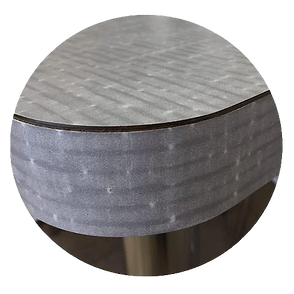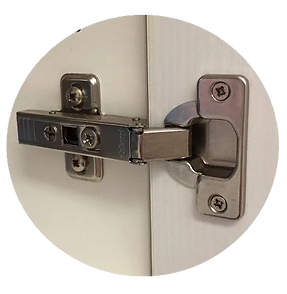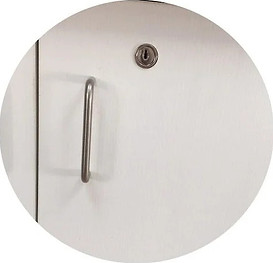Millwork Care & Maintenance
All construction-related products, regardless of material, have particular care and storage requirements. Woodwork is not unique in this respect.
Architectural woodwork should be treated like fine furniture, particularly that which is constructed of wood finished with a transparent finish system. Modern commercial finishes are durable and resistant to moisture.
FINISH MAINTENANCE:
With the exception of true oil-rubbed surfaces, modern finishes do not need to be polished, oiled, or waxed. In fact, applying some polishing oils, cleaning waxes, or products containing silicone may impede the effectiveness of touch-up or refinishing procedures in the future.
No abrasives, chemical or ammonia cleaners should be used to clean woodwork surfaces. Routine cleaning is best accomplished with a soft, lint-free cloth lightly dampened with water or an inert household dust attractant. Allowing airborne dust, which is somewhat abrasive, to build up will tend to dull a finish over time.
Remove oil or grease deposits with a mild soap, following the directions for dilution on the container.
IMPACT:
Avoid excessive or repetitive impact, however lightly applied. The cellular structure of the wood will compact under pressure. Many modern finishes are flexible and will show evidence of impact and pressure applied to them.
HEAT:
Avoid localized high heat, such as a hot pan or plate, or a hot light source, close to or in contact with the finished surface. Exposure to direct sunlight will alter the appearance of woodwork over time.
HUMIDITY:
Maintain the relative humidity around the woodwork in accordance with the guidelines published in these standards, every hour of every day, to minimize wood movement.
ABUSE:
Use the trims, cabinets and fixtures, paneling, shelving, ornamental work, stairs, frames, windows, and doors as they were intended. Abuse of cabinet doors and drawers, for example, may result in damage to them as well as to the cabinet parts to which they are joined.
OXIDATION:
Is a reaction of acids in wood (e.g., tannic acid), with iron, oxygen, and moisture, whether this is relative humidity or direct moisture. Control of moisture is a simple way to protect wood products from stains as a result of oxidation.
MOISTURE:
Architectural woodwork, when properly finished, is relatively durable and resistant to moisture. Prevent direct contact with moisture, and wipe it dry immediately should any occur. Allowing moisture to accumulate on, or stay in contact with, any wood surface, no matter how well finished, will cause damage.
REFINISHING:
Contact us to explore the options for repair or refinishing. It is often more cost-effective to replace damaged woodwork elements rather than attempting large-scale, on-site refinishing.
RELATIVE HUMIDITY AND MOISTURE CONTENT
The space in which architectural woodwork is to be installed should be engineered with appropriate humidity controls to maintain its optimum relative humidity. Wood for architectural woodwork manufacturing use needs a moisture content within an optimum range.
A major cause for failure in architectural woodwork is the lack of controls for maintaining a consistent, year-round, appropriate relative humidity in a building or building space. Wood is susceptible to movement, shrinkage, expansion and warpage when exposed to air that has not been humidified. Without considerations made to properly regulate the relative humidity in any space containing architectural woodwork, some degree of failure of the woodwork can be expected.
The range of relative humidity change should not exceed 30 percentage points. Relative humidity outside the range of 25-55% for this region is particularly harmful to wood and wood products.
RECOMMENDATIONS
CLIMATE CONTROL MAINTENANCE of relative humidity every hour of every day, within the ranges shown previously in this section, is important. Uncontrolled extremes such as those listed below will likely cause problems:
-
Relative humidity, above or below the ranges shown previously in this section.
-
Sudden changes in the allowable relative humidity, especially when it is repetitive.
USE:
-
Trims, cabinets and fixtures, paneling, shelving, ornamental work, stairs, frames, windows, and doors as they were intended.
-
Abuse of cabinet doors and drawers, for example, may result in damage to them as well as to the cabinet parts to which they are joined.
AVOID:
-
Excessive or repetitive impact, however lightly applied. The cellular structure of the wood will compact under pressure. Many modern finishes are flexible and will show evidence of impact and pressure applied to them.
-
Localized high heat, such as a hot pan or plate, or a hot light source, close to or in contact with the finished surface. Exposure to direct sunlight will alter the appearance of fine woodwork over time.
CLEANING:
-
Should be routine and accomplished with a soft, lint-free cloth lightly dampened with water or an inert household dust attractant. Allowing airborne dust, which is somewhat abrasive, to build up will tend to dull a finish over time.
-
Remove oil or grease deposits with a mild soap, following its directions for dilution.
-
Do not use abrasives, chemical or ammonia cleaners on fine architectural woodwork surfaces.
Care & Maintenance Simplified

Plastic Laminate & Melamine Surfaces
No abrasives, chemical or ammonia cleaners
Clean with a soft, lint-free cloth lightly dampened with water or an inert household dust attractant
Do not flood-wash, as moisture may get into joints causing lifting and/or expansion of substrate materials

Solid Surfacing & Quartz
Clean with warm soapy water or non-abrasive household cleaners
Please refer to your specific brand of solid surfacing for care
Do not flood wash as moisture may get into joints causing lifting and/or expansion of substrate materials

Wood Finishes
No abrasives, chemical or ammonia cleaners
Clean with a soft, lint-free cloth lightly dampened with water or an inert household dust attractant
Do not allow moisture to build up on surfaces

Hinges
Adjust concealed hinges with a screwdriver
This maintenance should be done on an annual basis or more often on high-usage doors

Drawer Slides
Bottom mounted—requires no lubrication
Side mounted—should be lubricated with non-staining white grease when they become “stiff” when opening and closing
Do not exceed the load capacity of the drawer

Cabinet Locks
Do not force the key in the lock — they will break
If not working smoothly, lubricate with a product such as WD-40® on a regular basis for smooth operation

Humidity Levels
Laminate and wood movement, shrinkage, expansion and warping happen with changing humidity and temperature levels
These issues are prevalent in Ontario with dry winters and changing summer humidity / shrinkage in the winter and expansion in the summer
AWMAC recommends indoor relative humidity between 25-55%
Consistent humidity controls are imperative for proper product performance

We Service What We Sell
We stand proudly behind our millwork
One-year guarantees are provided against defects in workmanship and materials.
If there’s a product issue, we’ll sort it out



